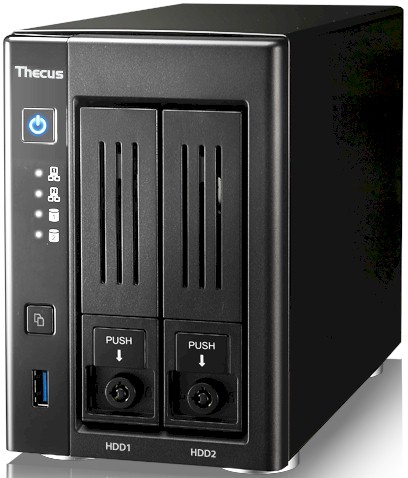
| At a glance | |
|---|---|
| Product | Thecus SOHO / Home NAS Server (N2810) [Website] |
| Summary | Two-bay dual-core Intel N3050 “Braswell” Celeron-based NAS with upgraded operating system |
| Pros | • Large library of downloadable apps • BTRFS support for snapshots • 4K video transcoding |
| Cons | • RAM upgrade requires complete disassembly • No eSATA port |
Typical Price: $0 Buy From Amazon
Introduction
The N2810 is a two-bay NAS recently added to Thecus’ SMB product family. Like several other recently reviewed NASes, including the Synology DS216+ and ASUSTOR 6102T, the N2810 is powered by a dual-core Intel N3050 "Braswell" Celeron CPU running at 1.6 GHz. All three products promote 4K Video transcoding as a major new feature – most likely enabled by the N3050 processor.
The chart below shows the Thecus’ current Linux NAS lineup. While the Thecus site offers product comparison, the N2810 and N2810PLUS are so new that they don’t yet appear in the comparison table.

Thecus Linux Product Lineup
The N2810 has its own Quick Installation Guide. The QIG is a short four pages and does not include illustrations for installing disks. There’s also a new 164-page user manual, common to the N2810 series and N5810 series, that covers all of the features including those of the new OS7.
The image below, taken from the User Manual, shows the front and rear panel callouts. It’s nice that the N2810 includes locking disk trays. Not called out on the rear panel, but present at the top of the case is a Kensington security slot for a security cable.
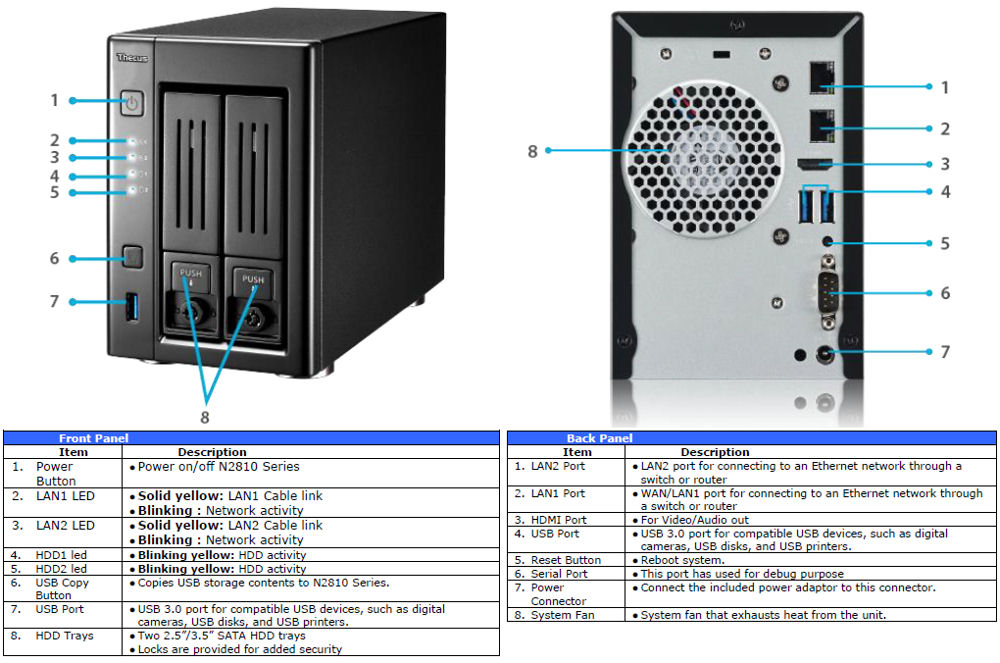
Thecus N2810 front and rear panel callouts
Inside
The image below shows the main board of the N2810. which appears to be OEM’d from Quanta Storage. The processor is covered with a heatsink. Below the processor is the single SoDIMM slot. To the right of the memory is the connector for the drive backplane.
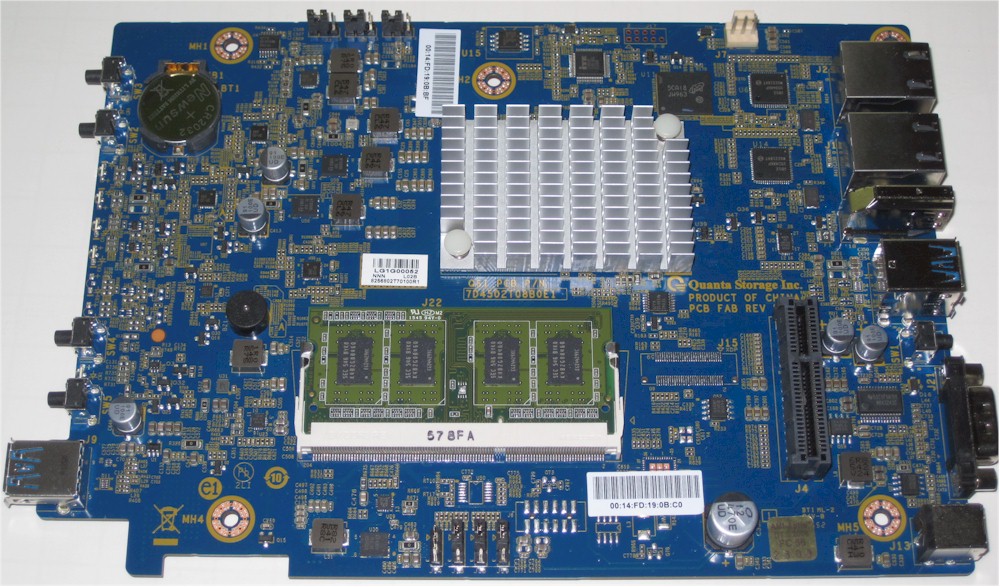
Thecus N2810 main PCB
For this review, we decided to compare the N2810 with the ASUSTOR AS6104T and the Synology DS216+ mentioned in the introduction. All three NASes use the same processor. But the Synology DS216+ appears to be at a slight hardware disadvantage with only 1 GB of RAM that can’t be upgraded without voiding warranty. Both of the other two NASes are upgradeable to 8 GB. But upgrading the memory on the Thecus N2810 is much more difficult than upgrading memory on the AS6102T. You pretty much have to entirely disassemble the N2810 to get to the SoDIMM slot
| Thecus N2810 | ASUSTOR AS6102T | Synology DS216+ | |
|---|---|---|---|
| CPU | Intel Celeron N3050 @ 1.6 GHz dual-core | Intel Celeron N3050 @ 1.6 GHz dual-core | Intel Celeron N3050 @ 1.6 GHz dual-core |
| RAM | 2 GB DDR3 SoDIMM (expandable to 8 GB total, not easily) | 2GB DDR3 Upgradeable to 8GB | 1 GB DDR3 |
| Flash | 4 GB MTFC4GMCDM-1M WT | ADATA IUM01-512MFHL (512 MB USB DOM) | 128 MB DOM (?) |
| Ethernet | Intel WGI210AT Gigabit Ethernet controller (x2) | Broadcom BCM57781 (x2) | Intel WG82574L (?) |
| USB 3.0 | In CPU | ASM1074 | Etron Tech EJ168A (?) |
| SATA | In CPU | ASM1061 (x2) | Marvell 88SE9170-NNX2 (?) |
Table 1: Key component summary
The N2810 drew 12 W with two WD Red 2 TB (WD20EFRX) drives spun up and 9 W with drives spun down. RAID 1 rebuild was immediate when the bad block check was skipped. Noise was rated as low with most of the noise coming from the fan.
Features
The N2810 comes with the recently introduced Thecus OS 7.0. OS 7.0 has a lot cleaner and more modern look than Thecus’ previous OSes, but doesn’t break new ground. Thecus OS 7.0 has features similar to those seen in competing products such as an application (package) store, and a control panel for controlling most features. The image below shows the N2810 desktop.
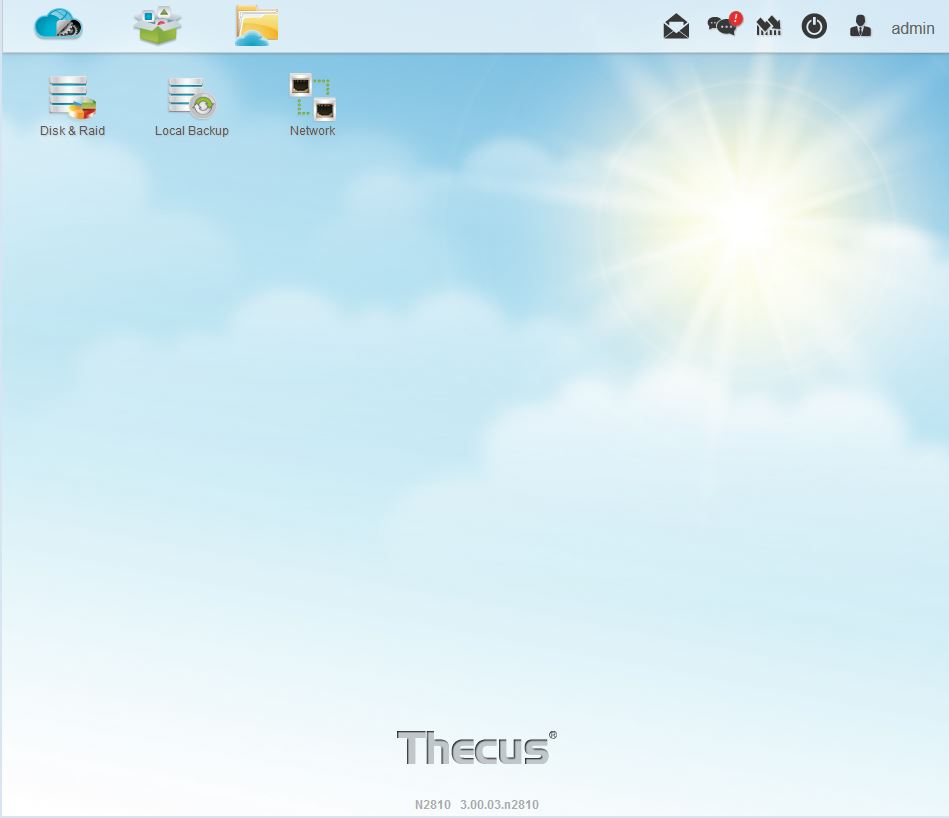
Thecus N2810 desktop
The control panel shown below has five separate categories: Control; Privilege; Storage; Services; and Backup.
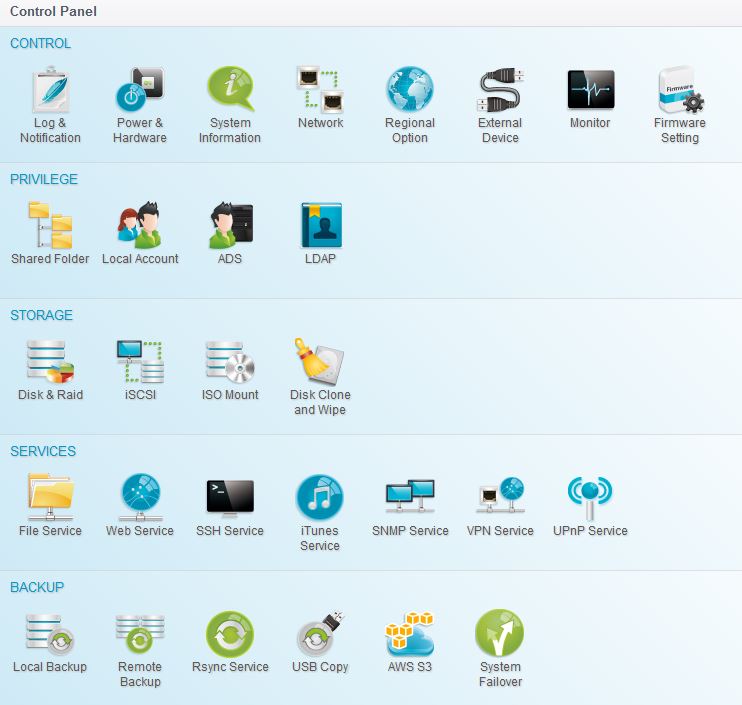
Thecus N2810 Control Panel
The image below shows the configuration details for the Services category. Each icon on the main control panel page has a submenu in the settings panel, and each submenu may have multiple tabs. This user interface is fairly intuitive and easy to navigate.
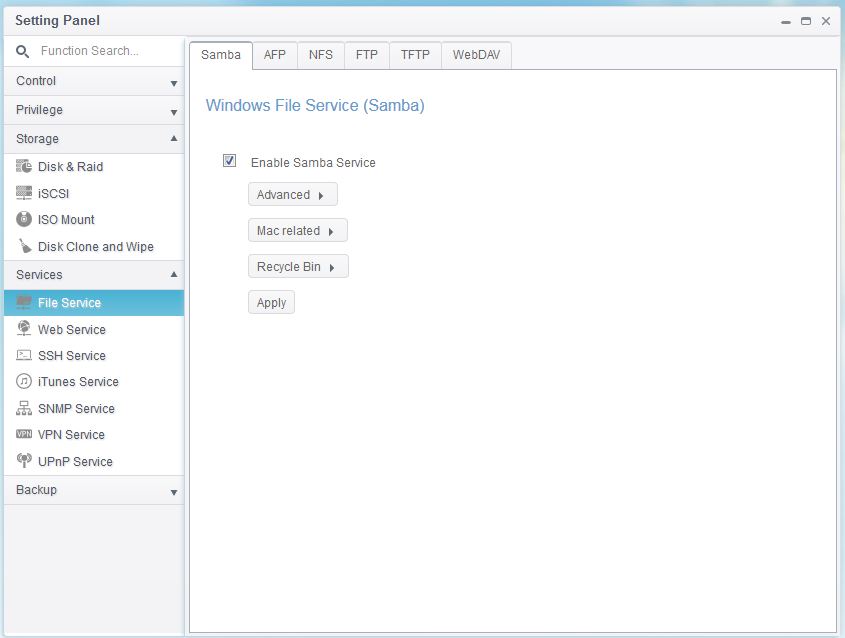
Thecus N2810 Services
Thecus OS7 also provides support for monitoring. In the Control->Monitor menu, there are tabs for monitoring CPU, Memory Hard Disk activity, and Network activity. The image below shows Hard Disk activity.
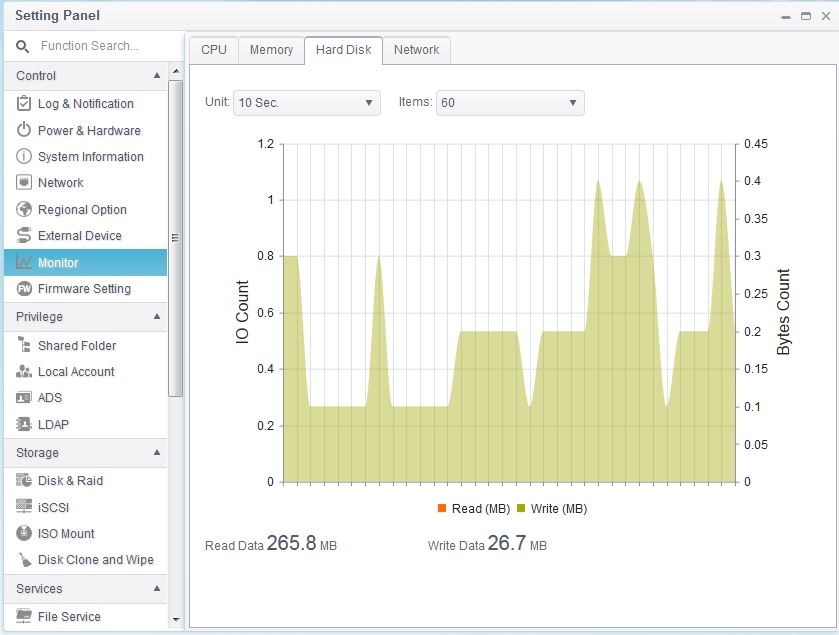
Thecus N2810 OS7 Hard Disk monitor
We found iSCSI could not be configured using Firefox 46.0.1 because buttons needed to perform actions were not visible. iSCSI was successfully configured using IE11. Note that Thecus is one of the few NAS vendors that support iSCSI initiator, which is included in the N2810.
Performance
Version 3.00.03.n2810 (Thecus OS7) firmware was loaded onto the N2810 and performance tests were run using the Revision 5 NAS test process. All tests were run using our own Western Digital Red 2 TB (WD20EFRX) drives. The test volumes were created using EXT4.
The composite image below shows File Copy Write and File Copy Read performance for two drive NASes tested with the Revision 5 test process. For File Copy Write, the N2810 turned in 109.7 MB/s which was slightly lower than the chart-topping 110.5 MB/s. For File Copy Read performance, the N2810 was near the top of the charts at 108.6 MB/s
Note that quite a few NASes in both charts cluster between 109 and 110 MB/s. That’s about the maximum throughput that you can achieve with single client Gigabit Ethernet testing. And, we have noted in other reviews, performance within 5% of each other is ranked the same. What’s important here is the N2810 is in the top tier and within the 5% tolerance for both tests.
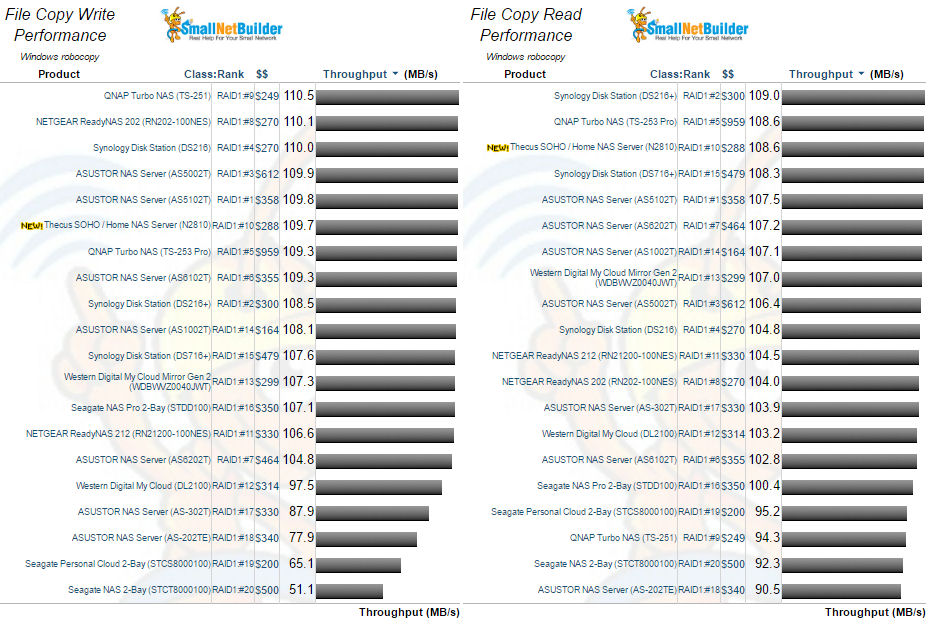
File Copy Write and File Copy Read performance for two drive NASes
For performance comparisons, I’m using the same products included in the Key Component summary table above. Both the Thecus N2810 and the ASUSTOR 6102T were tested with the EXT4 file system. The Synology DS216+ was tested with the default BTRFS file system.
The benchmark summaries below show the individual test results for each of the three selected products. For all three products, both the RAID 0 and RAID 1 File Copy Write and Read benchmarks were within a couple of percentage points of each other and near the maximum throughput of a single Gigabit Ethernet client. NASPT File copy to NAS and File Copy from NAS were similarly consistent for both RAID levels with the exception of File Copy from NAS for the Thecus N2810. It turned in a performance that was well below 100 MBps – 88.9 MBps for RAID 0 and 81.7 MBPS for RAID 1.
The N2810 lacks USB 2.0 ports as well as eSATA ports, so tests could only be run for USB 3.0 and network backup. For USB 3.0, the Synology DS216+ had the fastest backup performance for all file systems tested (FAT, NTFS, EXT3). The Thecus had the best network backup by a significant margin. It measured 108.9 MB/s compared to the AS6102T (59.5 MB/s) and the DS216+ (57.2 MB/s). The N2810 also outperformed the other two NASes for iSCSI Write and Read.
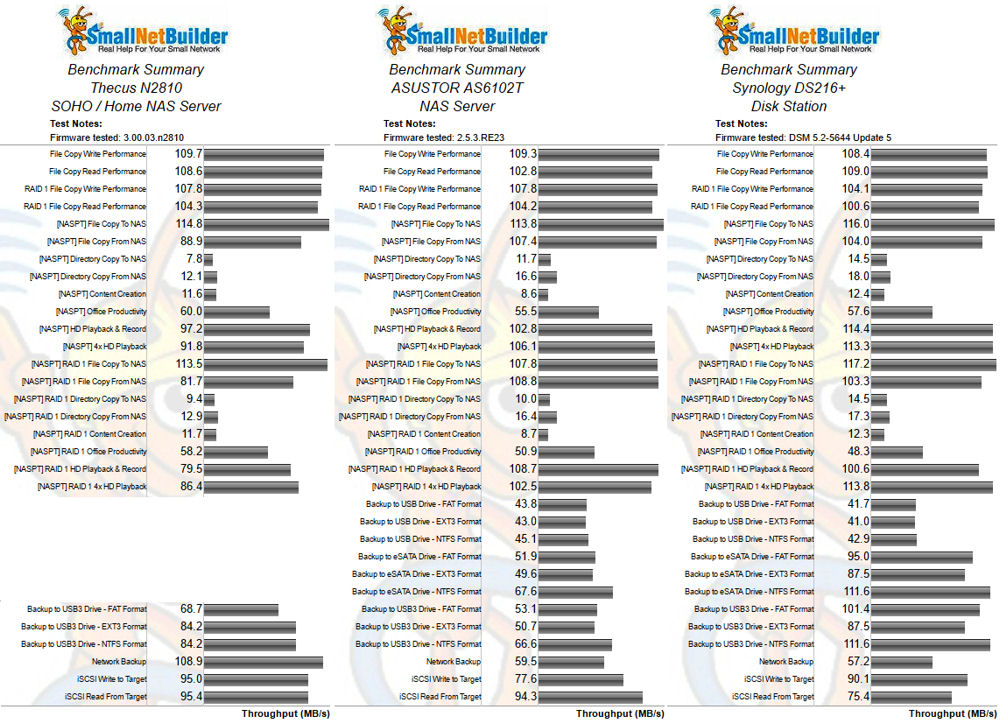
Benchmark summary comparison
The composite NAS ranker chart below was filtered for RAID1 and Revision 5 testing and sorted by rank. Priced at $288, the Thecus N2810 is the least expensive of the three NASes compared. But it also ranks #10 (lower) than either of the other two compared NASes.
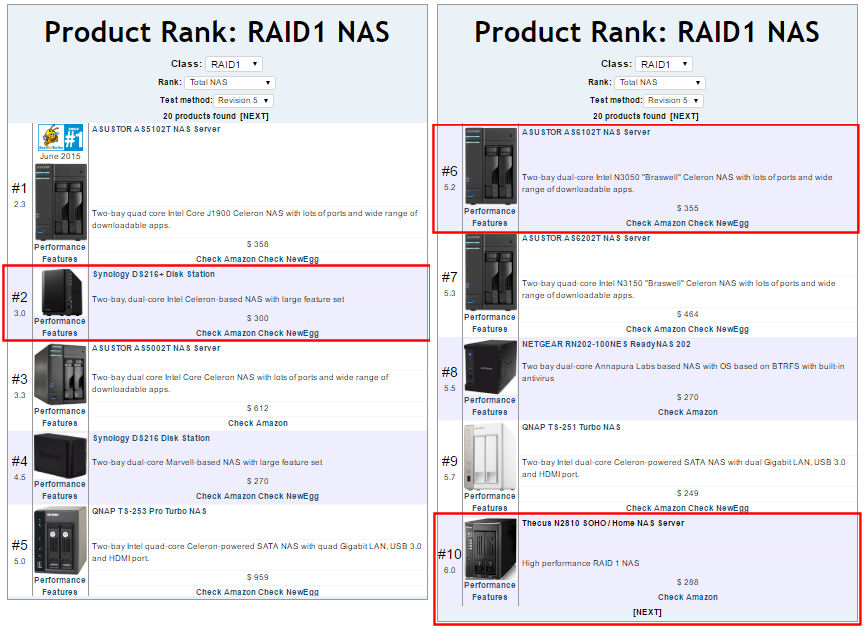
RAID 1 NAS Rank – Sorted by rank
If you sort the NAS Ranker by price, however, something interesting pops out. There are three NASes that are priced lower than the N2810 and also have a better (lower) NAS ranking. As we have seen in other reviews of two-bay NASes, the #4 ranked Marvell-based Synology DS216 offers a lot of bang for the buck.
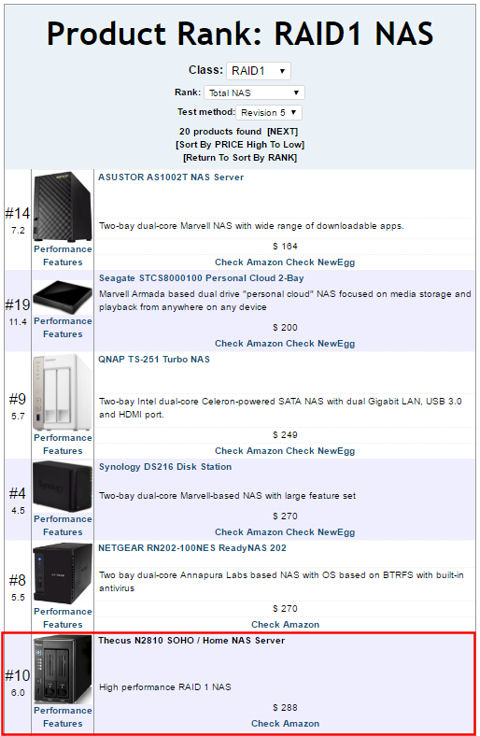
RAID 1 NAS Rank – Sorted by price
The chart below shows the individual and category scores for the same three NASes used in the benchmark summary above. The Thecus N2810 had only one category win – iSCSI – compared to the other two NASes. The N2810 did fairly well in the backup category, but the relatively slower NTFS USB 3.0 result dropped it behind the Synology DS216+. Mixed Read Write was also a good category where the N2810 placed just behind the #2 ranked DS216+. The N2810 ranked #11 for Read Benchmarks primarily because of the relatively low NASPT RAID 0 and RAID 1 File Copy read tests previously noted.
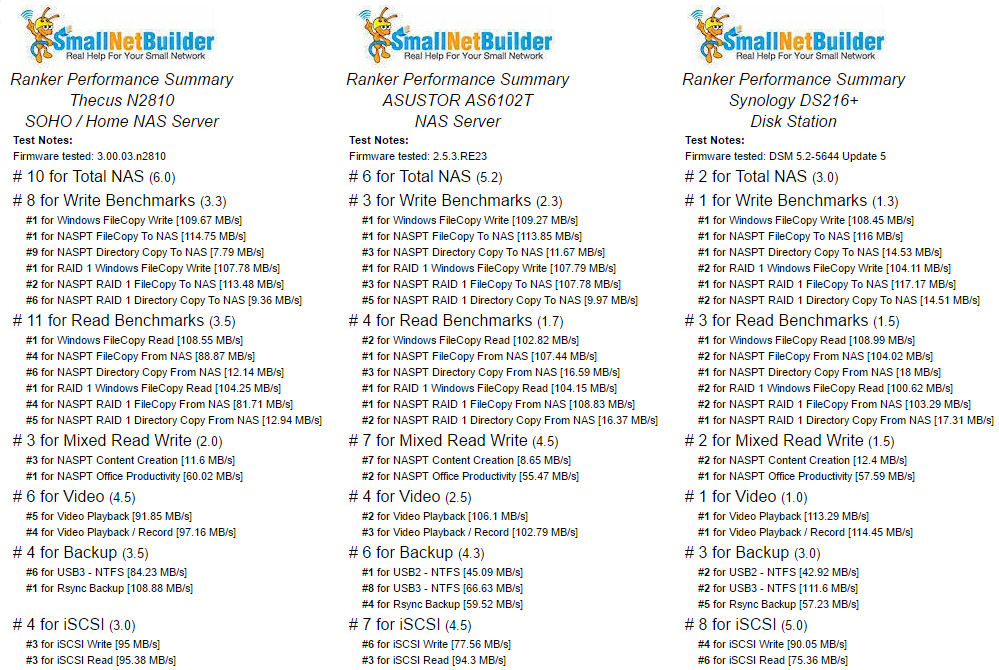
Ranker Performance Summary comparison
Closing Thoughts
The Thecus N2810 is priced about the same as the QNAP and Synology Intel Braswell-based NASes we’ve reviewed, but ranks significantly lower in our performance rankings. That said, in real-world use with a single Gigabit Ethernet connection, you would have a difficult job seeing much difference in file copy performance.
OS 7 aside, Thecus still lags behind QNAP and Synology in features and user interface sophistication for "kitchen sink" NASes, i.e. products looking to offer as many features as possible. So it’s unlikely to win any converts from those camps. But if you’re a Thecus fan looking to move up to a more powerful RAID1 class NAS, the N2810 won’t disappoint.![]()
